The wonderful world of travel backpacks is getting better and better every day. Back several years ago I was going crazy with just one or two options, and then a perfect storm of a bunch of pissed-off travelers with enough free time to deal with this problem all seemed to hit the market at the same time, and more and more people have realized how much better everything could be ever since.
The latest offering I’ve had the chance to try is the Aer Travel Pack, from a small company that got its start in workout bags, and have entered the travel backpack market with quite a strong offering. It has more organizational options than just about anything else I’ve seen, along with the conveniences of laptop storage, panel-loading access, and carry-on dimensions. If you’re organizationally obsessed, you’ll definitely want to give this a look.
Aer sent me a free test sample to try out, and I’ve had it for a couple months now. Here’s what I think.
The Aer Travel Pack, in review
Here it is:
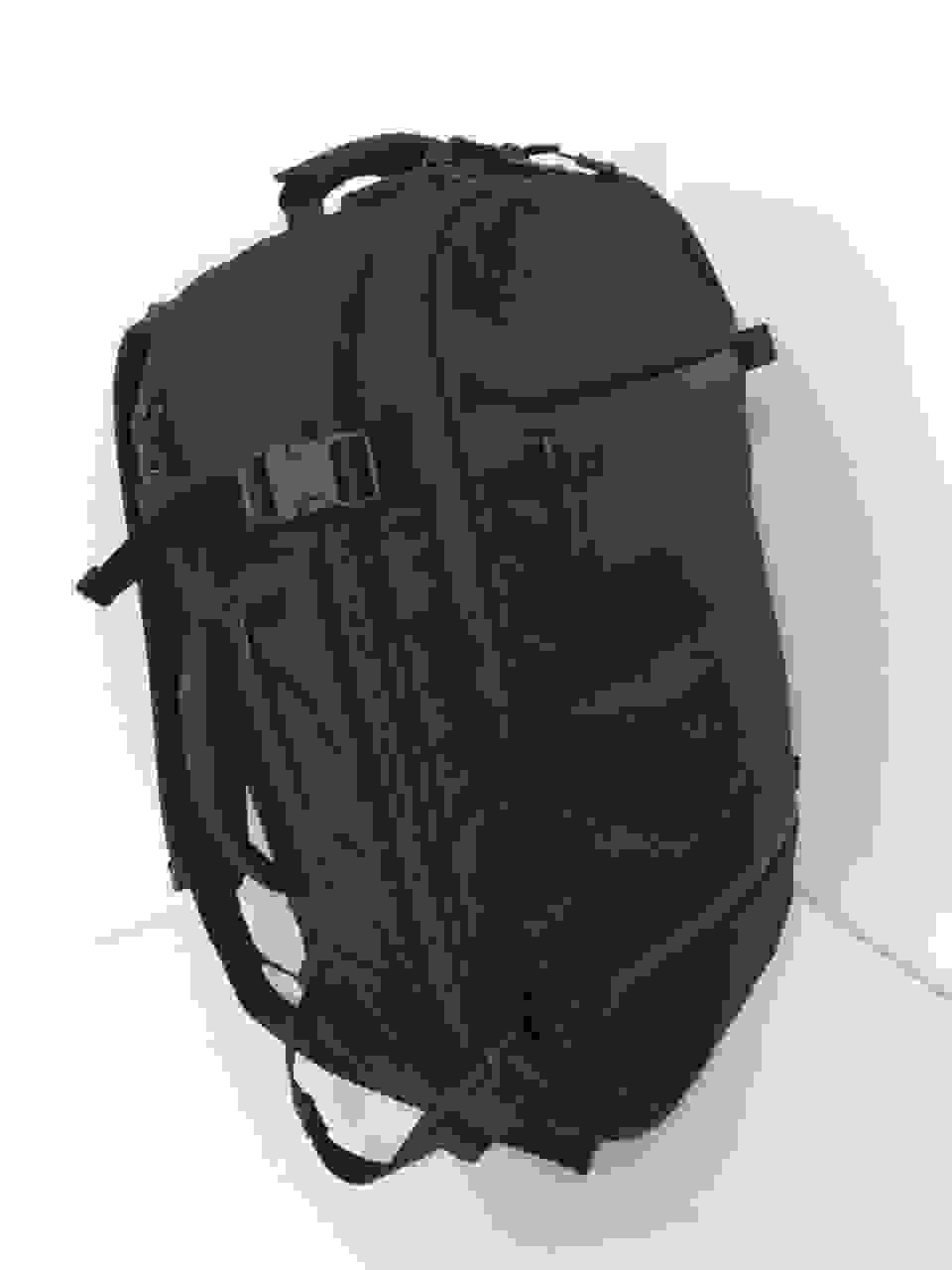
It’s packed with features, but let’s start with the numbers.
Specifications
- Height: 21″
- Width: 13″
- Depth: 8.5″
- Volume: 33 liters
- Weight: 4 lbs, 4.7 oz (1.9kg)
- Price: $220
It was a little heavier on my scale at home than the listed weight, but it was fairly close. Weight is definitely going to be one of the drawbacks to this pack, as it’s one of the heaviest I’ve seen (just behind the GoRucks), but because it has more built-in organization than just about anything out there, you might carry (and buy) fewer items like packing cubes as a result.
Carrying options
One of the things this pack does differently from some of the other travel backpacks out there is that it’s only a backpack; the straps don’t store away anywhere, and there’s no shoulder bag option. But if you only ever use it as a backpack, and never check it, then you might be fine with this (especially since it’s designed to be a mini-carry-on, which is smaller than North American carry-ons). But those grab handles on the top and side are certainly useful, especially for getting it in and out of overhead bins.
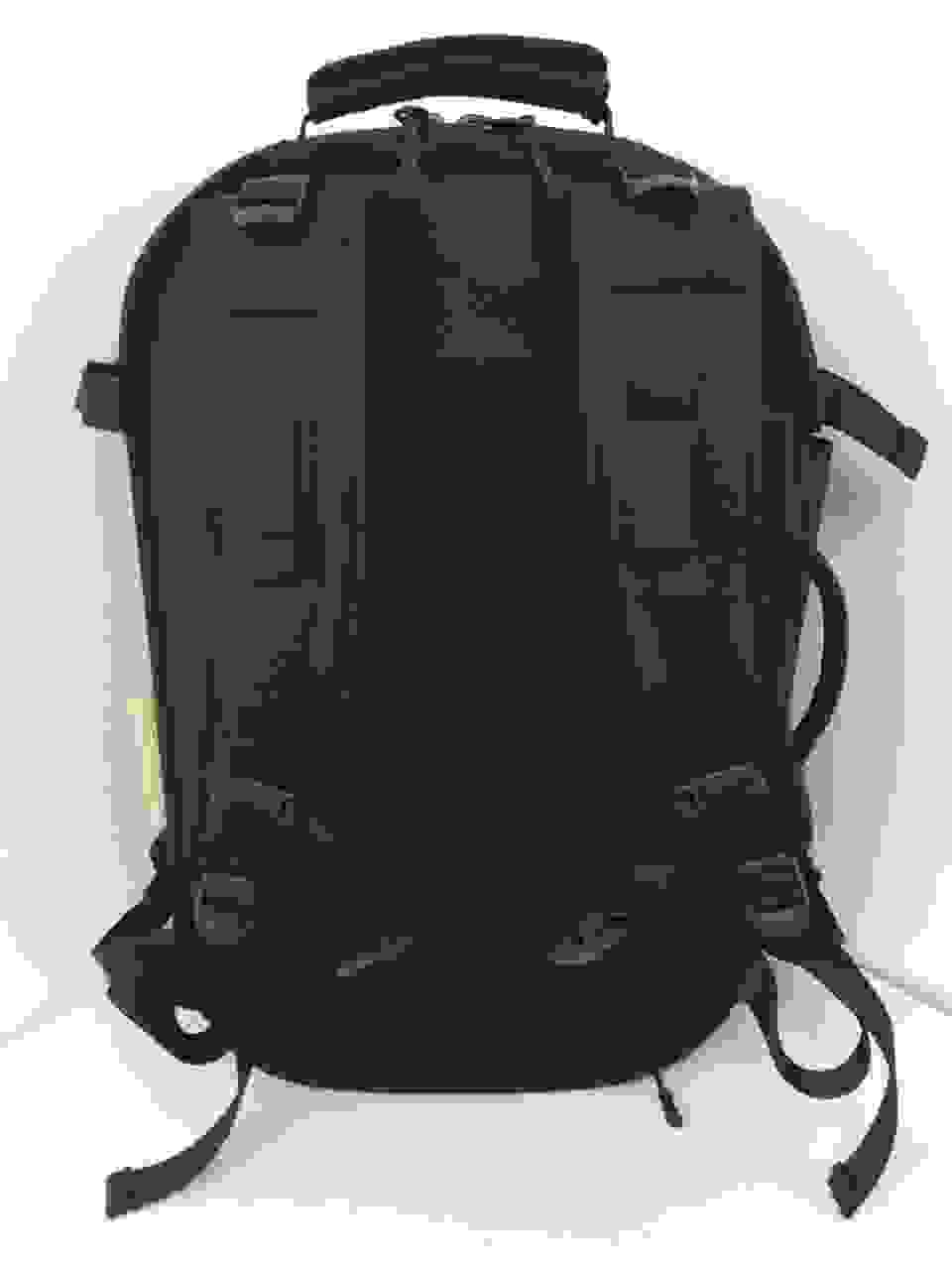
On the subject of straps, this is another area in which this pack will work for certain people, but not others; the straps are a little wider than I’ve seen elsewhere, at 3.25″ wide. For comparison, the Minaal’s are 2.5″ wide, and my Synapse 25 has them at about 2.4″. The straps on the Aer are also just a teensy bit closer together, meaning that when tightened up as snugly as I would have liked, the straps started digging into my neck on either side, so I had to wear it just a bit lower than usual.
This is only something that’s going to happen for smaller people, so if you’re any larger than I am (I wear a men’s size small t-shirt), then you’re going to be fine. But combine this with the lack of hip belt and the relatively high weight, and I think this is a pack that will more likely work for larger people than smaller people.
Organization
This is where this pack shines. It has a grand total of seven exterior pockets in addition to the main compartment, which might be the most I’ve seen on any backpack, ever. If you’re obsessed with every tiny item having its own home, you can’t go wrong here.
On the front are two zippered pockets:
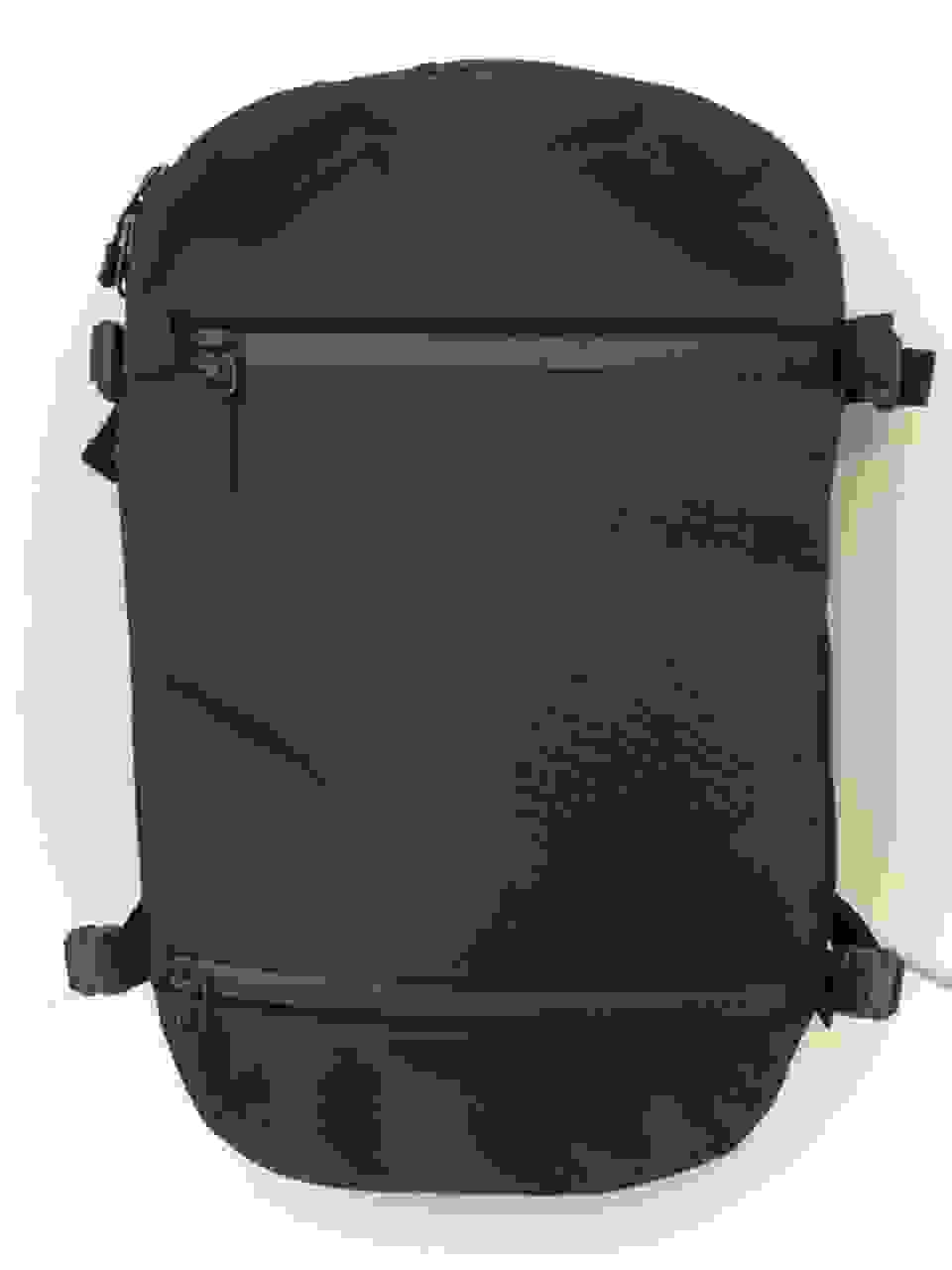
The higher pocket extends all the way from the top zipper to the bottom zipper, and the lower pocket extends from the lower zipper to the bottom of the pack. You can see the folds in the four corners of the pack, meaning these pockets are three-dimensional, expanding to accommodate bulkier items better than flat pockets would.
Here’s the laptop sleeve, up against the back panel:
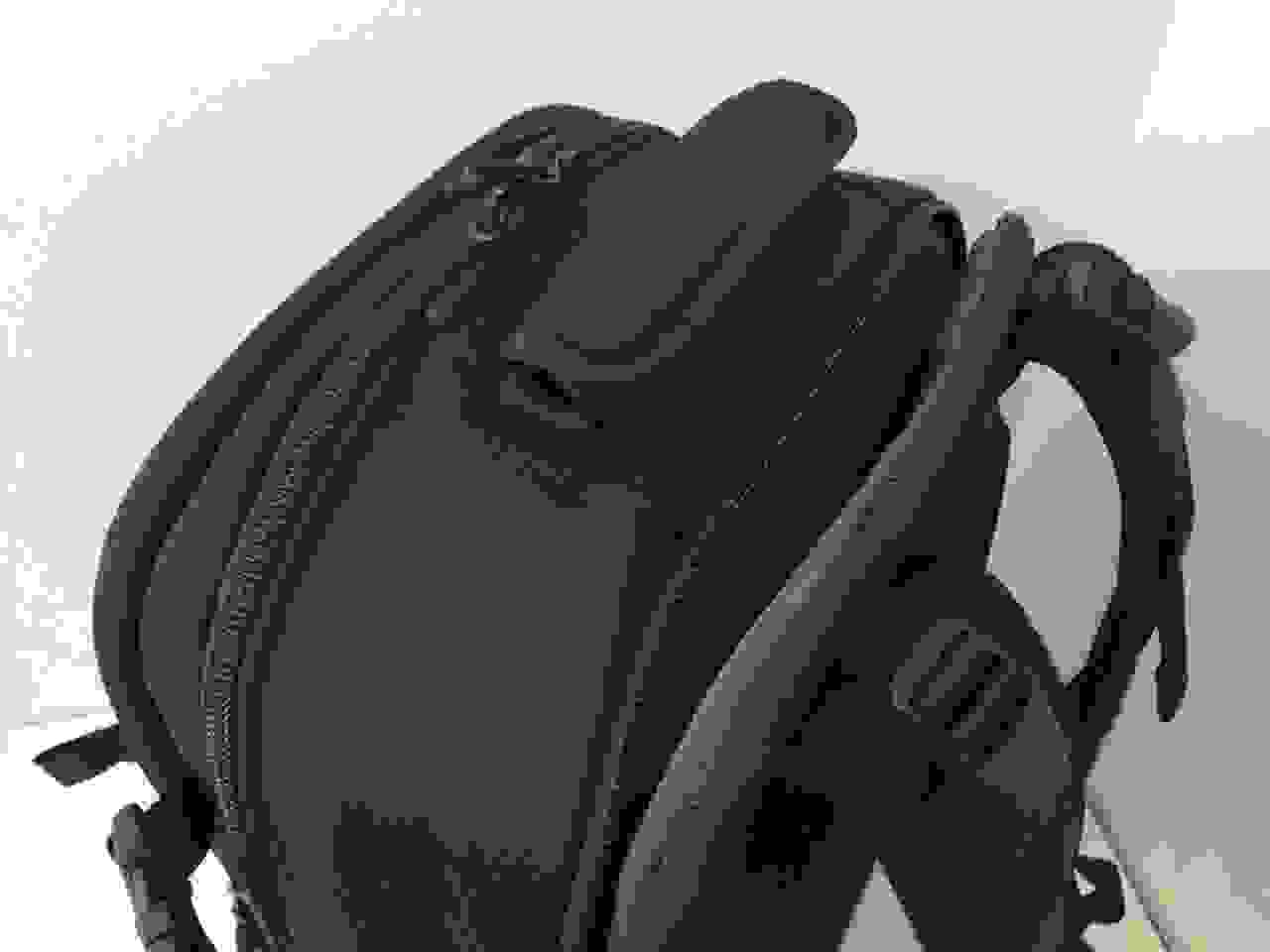
The laptop compartment is padded and suspended, so the laptop won’t bang into the ground if you drop it. It’s not secured from a fall from the top, though, but it’s probably going to fit so snugly when fully packed that it’s not likely to move at all.
There’s also this little top pocket:
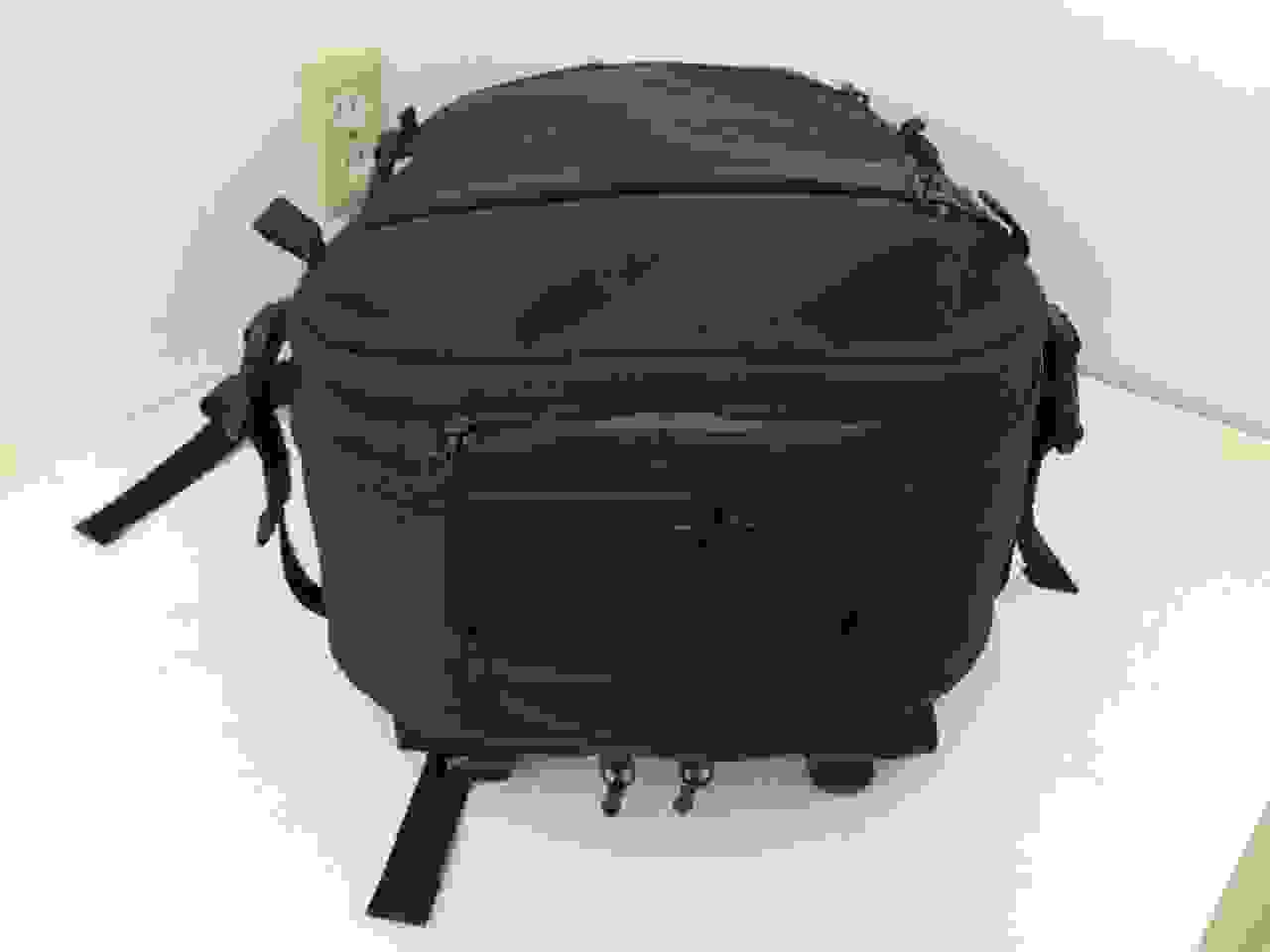
I actually felt that with all the other pockets all over the pack, that this one was perhaps unnecessary, but plenty of people like just a single, small pocket on top, for throwing in a few small papers and ID cards and things like that. It’s definitely helpful in the airport security line, when you have to empty out your pockets before the scan.
And here we have what is probably my favorite part of the whole pack, which is the organizer panel, in the front compartment:
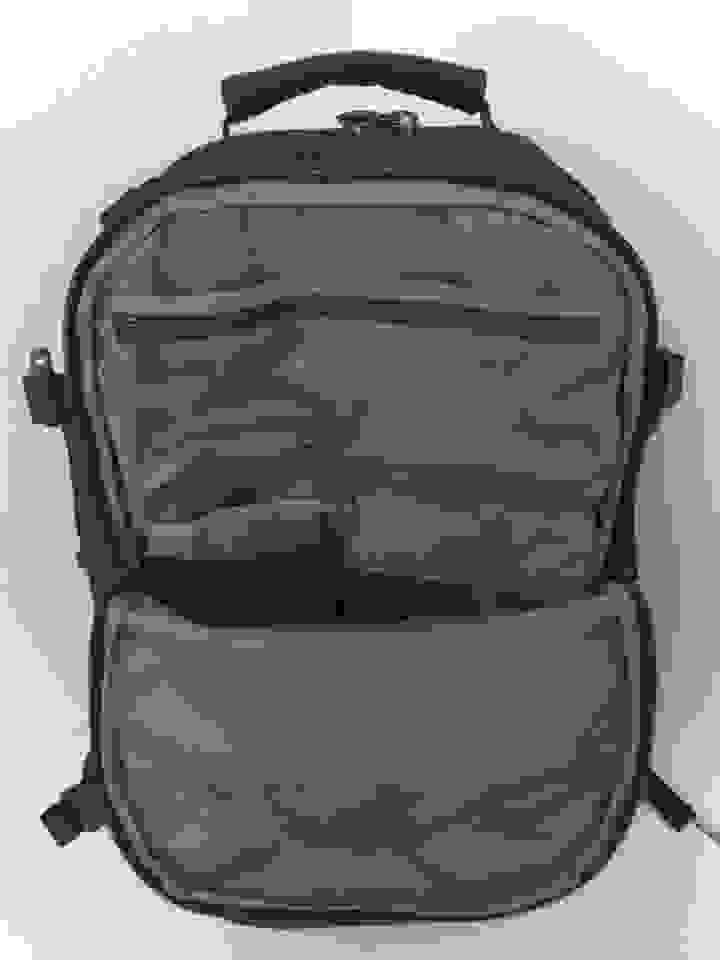
If you count them up, there are a total of five pockets in there; on top, there’s a long, open-top, drop-in slot (just above that zipper), which is big enough for a tablet, papers, notebooks, and so on; underneath is that zippered pocket; down on the left there’s a velcro drop-in and a mesh drop-in pocket; and down on the right there’s that flap pocket, which is padded. This compartment extends all the way down to the base of the pack, so you can throw things loosely down to the bottom as well. I think a couple dedicated pen slots would have been nice, but they’d hook over that velcro compartment pretty easily.
Over on the side, there’s a water bottle pocket, which zips open and closed as needed, so it won’t get snagged when it’s not in use:
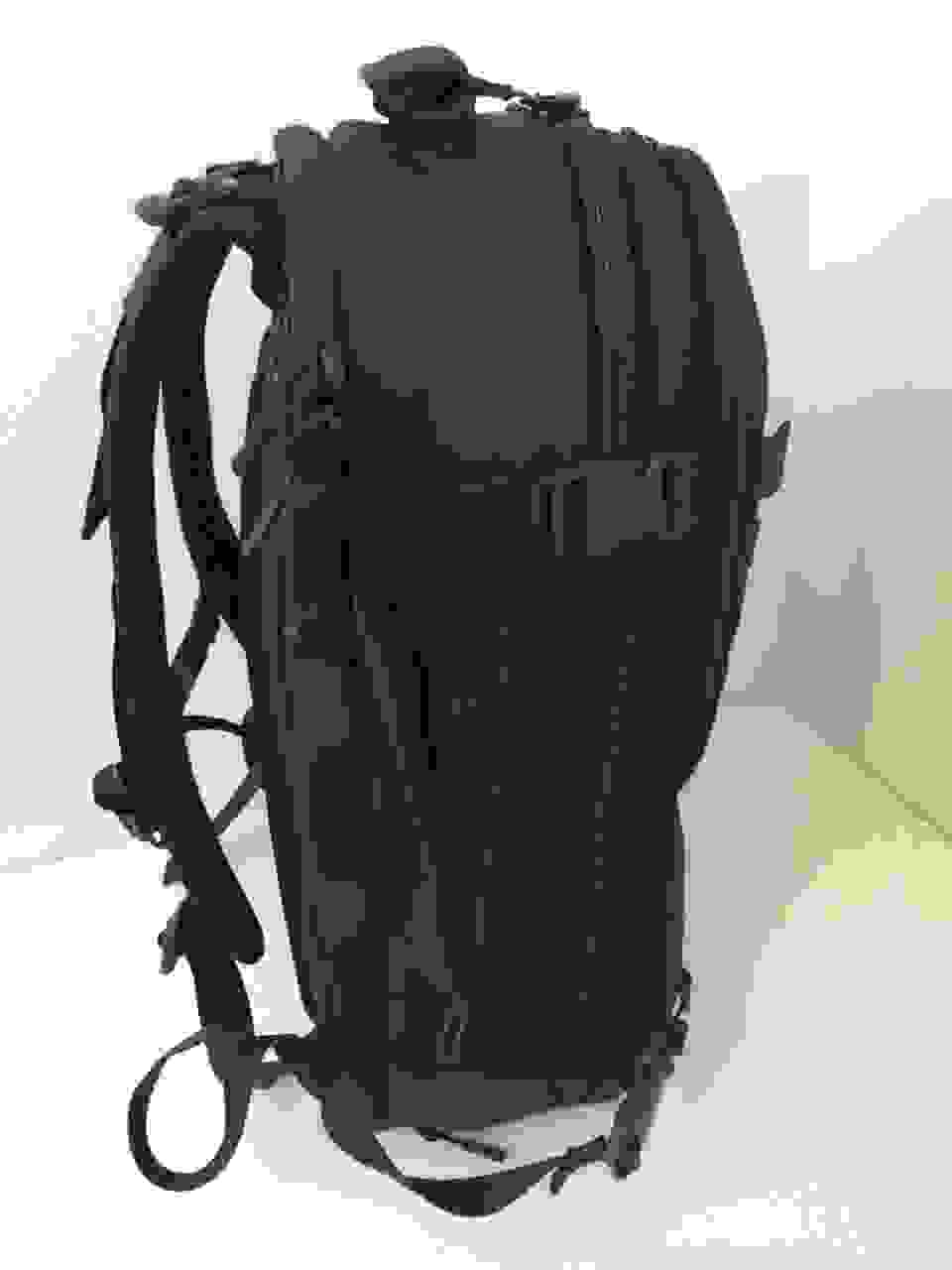
I like this pocket design a lot, although it was actually pretty tight. I suggested expanding the mesh so it could accommodate slightly larger bottles, so hopefully that’ll happen at some point. Half-liter bottles should be okay, but maybe not insulated ones, as they tend to be a little wider.
Down below, there’s the shoe compartment, which is a signature feature throughout their product line:
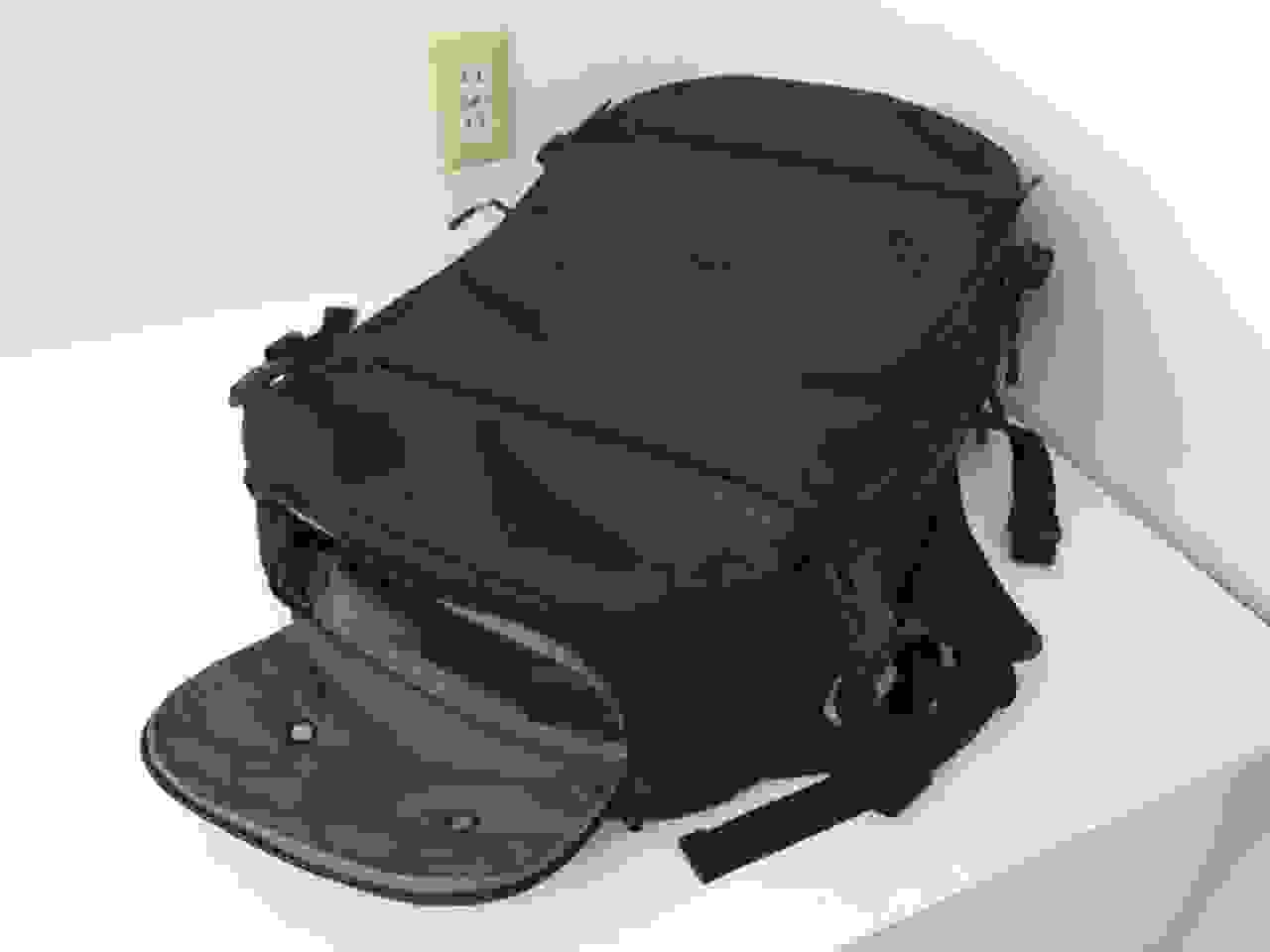
Drainage ports allow moisture and odor to escape, and the pocket can be flipped inside out, so it can be rinsed off pretty easily. It’s quite spacious, as you can see when you open up the main compartment:
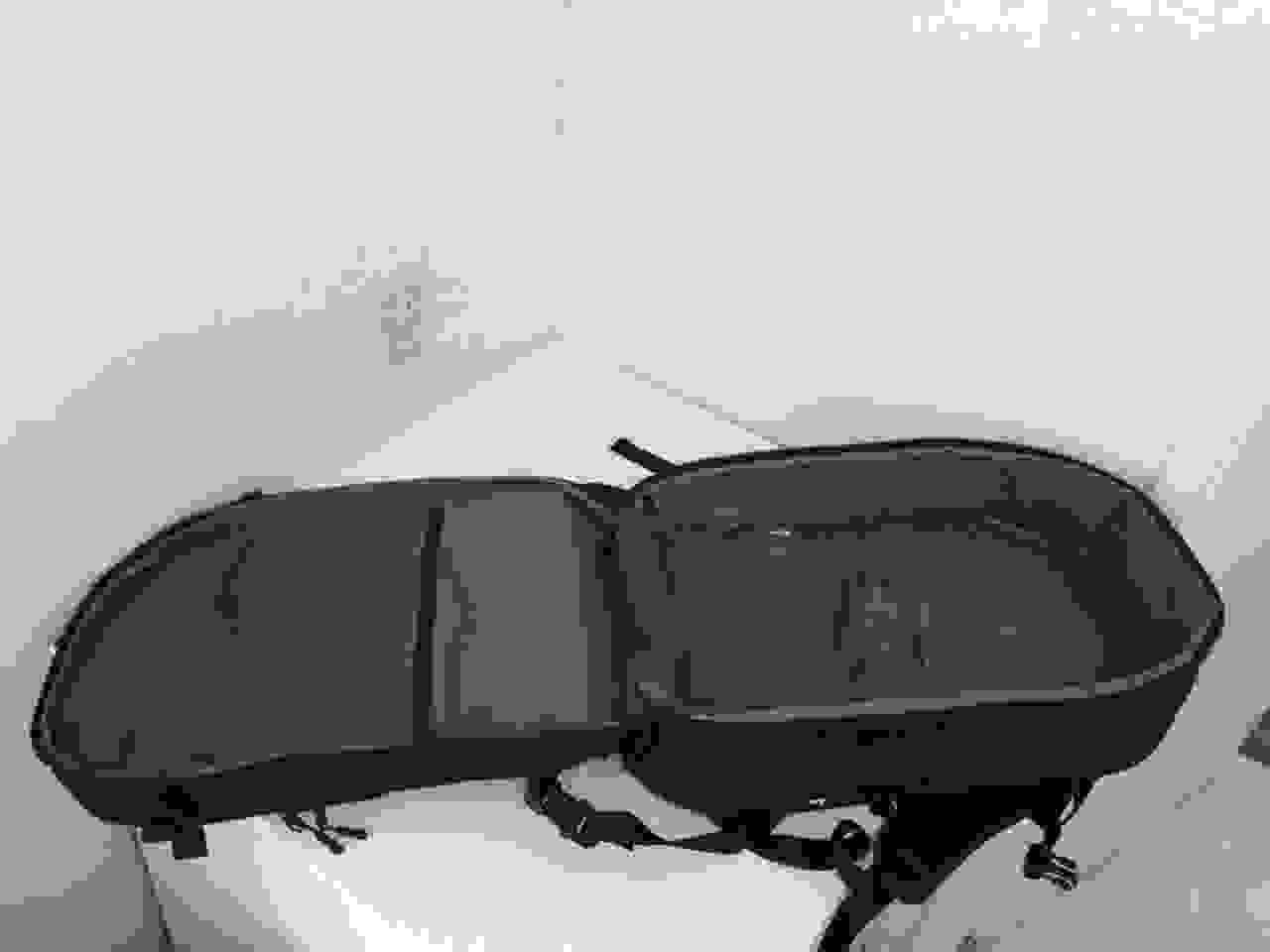
The walls of this chamber are actually quite stiff and padded, meaning you can stuff a whole lot in there without dealing with flimsy sides, which can occasionally lead to smaller items falling out. It’s actually quite shallow, however; only about 4 inches deep, which I consider a good thing; the other pockets, such as those front drop-in pockets pictured above, are actually three-dimensional, meaning you’d only put your extra changes of clothing in this main compartment, and you’d pack the exterior compartments with jackets, books, hats, and other items, rather than trying to fit everything into this compartment.
There’s a zippered pocket on the door (on the left in that photo), but the pocket extends throughout the entire length of the door, accessed just through that single zipper; I suggested splitting it up into two separate pockets, each with its own zipper, so items don’t get lost sliding around in there. Right now it’s a little tricky with just the one zipper, but I suppose in the meantime you could use it as a laundry stash, since you don’t have to see inside in order to grab a specific item.
Compression
The pack has four side compression straps, so you can tighten things down, or even turn it into a daypack:
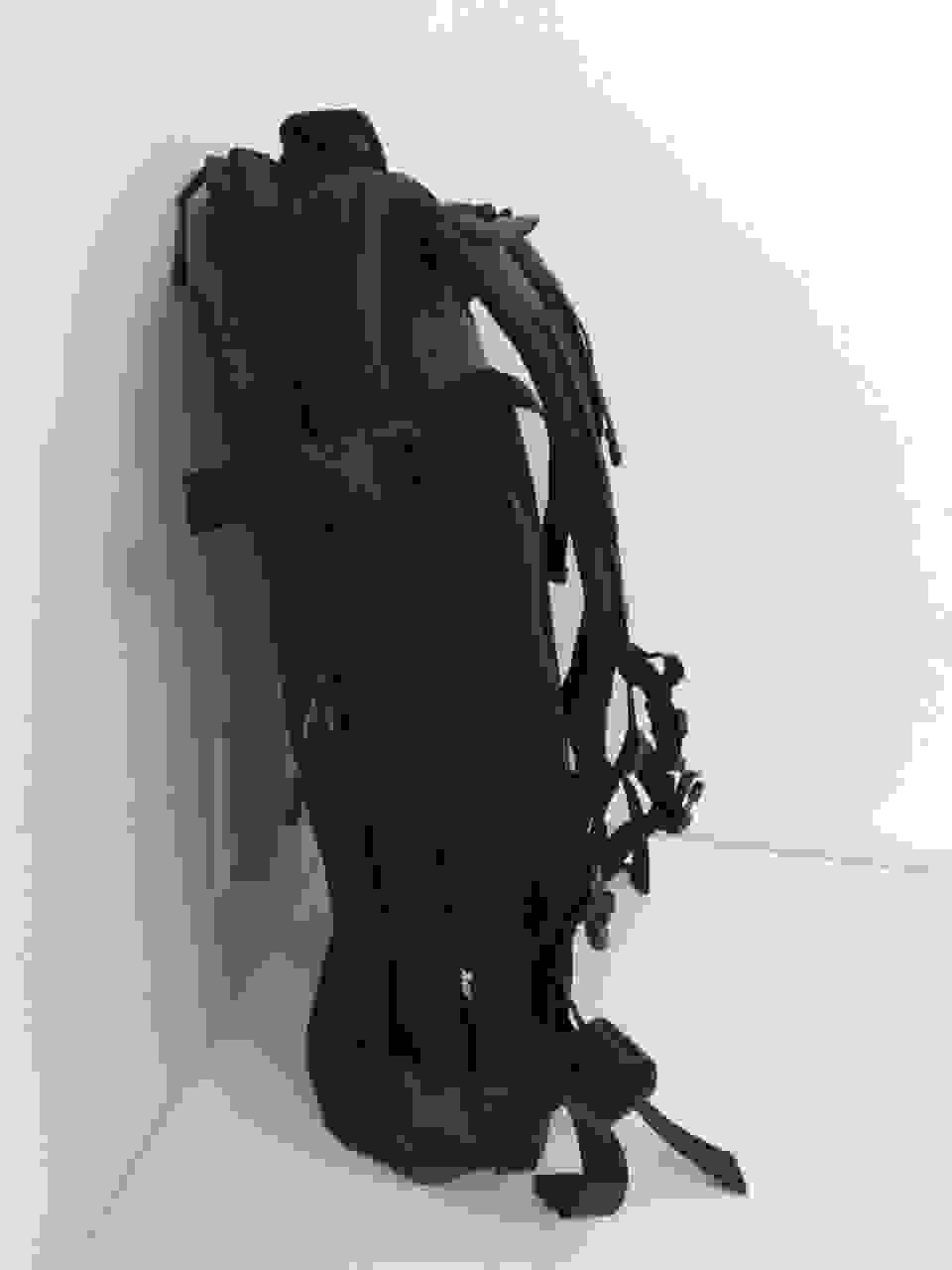
I expect most people won’t really make use of this feature very much, since you could pack just the exterior pockets, and there wouldn’t be much point in cinching down the straps, since everything is in its place and nothing needs to be tightened. But on the other hand, the compression straps are a good way to attach something to the outside of the pack, like a rain jacket that’s still damp, so it’s not such a bad idea to have them around. I’ve seen another review that suggested eliminating some of the exterior straps, which I’d be mostly fine with, but it would come at the expense of not having an easy exterior lash strap option.
Conclusions
This pack is going to be polarizing; it has better organizational options than just about anything I’ve seen, with plenty of exterior storage, as well as that organizer panel for all sorts of smaller items that you don’t want getting lost everywhere. The sheer number of compartments and pockets-within-those-compartments is easily its biggest strength, and I don’t even mind the higher weight so much, since you won’t feel the need to use packing cubes or other organizers.
On the downside, this is probably going to be a pack for larger people, as mentioned in regards to the straps; they’re wider than most, and also rather stiff, so they might not work for people who cinch the straps really tightly, as they’ll eventually start digging into your neck. It also lacks a hip belt, which tends to be a problem for smaller travelers, or those going on longer walks.
Aside from that, it has everything else going for it you’d want in a travel pack; a padded laptop sleeve, panel-loading access, a huge number of easily-accessible, well-placed exterior pockets, organization on the inside as well, and a great aesthetic.
Smaller people might want to consider alternatives (such as the Minaal, which I find works quite nicely for my small frame), but if you’re slightly broader in the shoulders, don’t mind the lack of a hip belt, and are obsessed with organization, then I think this might just be for you.
You can pick it up from Aer. It’s also on Huckberry, though occasionally in limited colors.




Lol, and here I thought the Minaal was a bit too heavy for its size. Loving the compartments though especially the shoe/laundry pocket.
Have you looked at Gregory travel packs (Compass, Border)? They seem lightweight and comfortable to put on.
I like Gregory a lot, and I think the Border series had a solid design, but it looks like they’ve cut the series down just to the 25 liter version now. The Compass looks a little odd to me. The pocket layout just seems a little weird. I’ve always thought they make really comfortable packs, though. Better than some of the other, better-known alternatives.
Hey Snarky,
Have you heard of a Taiwanese company called Hanchor? They make urban travel/rock climbing packs from 25 up to 65 liters. They have a backpack called the Pipe-T1 that looks great for ultralight travel but I haven’t seen anyone talking about them. Heck, Hanchor isn’t even listed on Carryology. You can check them out here h++ps://www.hanchor.com/
Might be worth a look.
Yeah, I’ve seen their main backpack, and there are definitely some things I like about it, but I like a little more internal division, but that’s a matter of personal preference. Just about everything when it comes to backpacks is.
My last travel bag bit the dust so I recently got a Gregory compass 30 bag. I haven’t had the chance to use it, but do like it. I originally purchased a Border (25 liter older model), but returned it because the zippers don’t go the entire way around, making it more of a regular type backpack.
The compass is very inexpensive (retail under 100) and very light. I might have last years model, but it is a very simple design, and don’t think there are a lot of changes. Zippers are on the back and it fully opens into one large compartment (duffel bag style). There is one other compartment on the back for laptop/tablet and then on the top of the bag a zipper pocket for quick access to items. There is a ton of room inside since it’s just one large main compartment.
I wish it had external pockets for a water bottle. Doesn’t have a hip belt, but I’m hoping this will not be a problem as the bag is light and I pack light. The shoulder straps are very comfortable and supportive.
Has some grab handles and easily under international carry on size limits.
Yeah, it looks like the Border series has been changed for this year, and only the 25 liter version exists. I don’t know if that’s permanent, but I do miss the 35 liter version that opened up like a suitcase, but maybe they thought the Compass series was pretty similar, so there wasn’t much of a reason to do both.
I’m super happy to see this review; if this pack had an option for a belt strap I’d definitely buy it!
Yeah, that was definitely one of my biggest suggestions. The way the Minaal and Tom Bihn use those easily-detachable hip belts is the best, so hopefully they’ll do something like that for the next version. The pack has some curvature toward the bottom, so they might have to make it a bit more square, but that would be fine.
Thanks for the review. I love the design and overall layout of this pack, and the only thing keeping me from purchasing it is the lack of a hip belt. I’ve thought about just having someone sew on some loops and using Minaal’s detachable hip belt, but I suppose it’d be best to wait and see if a belt shows up in version 2…
Thanks for reviewing this one. I tried bringing it to your attention 2 months ago but your quirky site wouldn’t let me post to it. Really good coverage.
Yeah, there’s a spam filter, but sometimes it gets overzealous. But it’s either that or I have to dig through a bunch of spam messages every day…argh.
Do the pulls have large enough holes for locks? How many locks would it take to close it all up? I really don’t like leaving unlocked bags in luggage rooms or hostels.
I’m currently using the Cabin Max bag, which is fairly low quality but very cheap. It is deliberately sized to be the largest bag you can carry on Ryanair and other European discount carriers with a smaller carry-on standard than real airlines. Its two main compartments can be locked together with one little cable lock.
Like all locks they’re really easy to defeat, but the purpose of all locks is to just keep people a bit more honest.
Yeah, I forgot to mention it, but you can lock the zippers, even though it doesn’t have “real” locking zippers. I think you’d need two locks; one for the laptop compartment, and another for the main compartment and organizer panel compartment, which are close enough that you can use one. There would be several unsecured zippers left over, but if you pack it correctly it’ll be fine.
If I invest in an expensive carry-on then the lack of a waist strap is a MAJOR turn off for me as I walk long distances and my loaded 35 litre day pack (without waist strap) feels about as comfortable as my loaded 70 litre hiking backpack (with waist strap).
I’m pretty tiny, so I’m inclined to agree, but there are some muscular people out there that don’t care for waist straps. I’m jealous.
It sounds like this isn’t going to be your main bag. Which one of all the bags you’ve tried are you going back to?
I’m pretty tiny, and for now the Minaal is working nicely for me, due to the hip belt and shoulder straps that work better for smaller people. The only downside is that I’d prefer rigid walls that make it easier to stuff things inside without the walls falling over, but packing cubes are definitely helpful with that. I’ve seen a couple announcements by a few other companies of packs coming out maybe this year, so it’s definitely getting busier, but I’ve noticed quite a few of them have no hip belt, which brings me back to some of the existing options.
I just discovered this bag from High Sierra http://www.highsierra.com.au/index.php/travel/at-8-range/convertible-carry-on.html with a similar amount of organisational pockets, for less money and lighter (the site says 2.1kg but handling it it’s definitely closer to 1kg), but without any hip or sternum straps.
All the zips can be locked and the backpack straps hidden away.
It’s not perfect but it might be a good, cheap alternative for some people.
High Sierra isn’t a bad option. I’ve known people to use some of their regular, everyday backpacks and they seem to work out well enough. I haven’t had too much experience with them myself, though.
Hi SnarkyNomad,
Thank you very much for this review.
How does this bag compare with the Synapse 25?
Aren’t the 33 liters too much for a one bag travel experience? I mean I guess I’d have to let this 33L bag at the hotel or in some coin locker to be able to visit a city.
What are your thoughts?
It kind of depends what you’re doing. Some people like to have just two or three changes of clothes, and don’t need significant winter gear. Personally, I need some extra layers in the winter, so I don’t mind the larger size here. I recently went on a trip with the 35 liter Minaal, which included burning hot summer days and below-freezing mountain village nights, and I used the whole pack. That’s partially because I had the water bottle on the inside of the pack (it was a little too big for the outside pocket), but also because I needed multiple winter layers in addition to summer gear, as opposed to a trip where I’d only need fall clothes.
Hey there. I’ve been following your blog for awhile now and getting lots of inspiration from it, but I’m almost completely new to this stuff and trying to work out the details of my personal project for this first time.
I’m trying to set up what would essentially double or triple as a “onebag,” basic “bugout bag,” and usually short–term wilderness backpacking bag all in one. I’ve put most of my efforts so far into trading and selling around other things I own to make my possessions as minimalist as possible, and now I’m entering into the whole terrifyingly confusing game of trying to figure out gear. Way out in the mountains too far from any store to possibly try anything on before buying it. Essentially, I want this to contain everything I need to live—which will almost be everything I own—and also have provisions for heading out into the mountains my house is on for writing retreats whenever I feel like it.
So far, the only things I need to fit are:
Clothes – A few merino shirts, a couple nylon/cotton shirts and pants from Vertx, a couple Tru–Spec Tru XTREME pants (not the most lightweight, and preppers will mock me for looking “tactical” if shit ever were to actually hit the fan, but bug off, I love everything about them and I’m not that paranoid about blending in), a not–very–lightweight rain shell (Blackhawk Advanced Waterproof), a down jacket (Brooks–Range Mountaineering Mojave), and a couple authentic keffiyeh. I’m thinking of trying to trade the shell and down jacket out for more lightweight/packable variations (I have these because I found them for $60 and $80 respectively), but I do like the Blackhawk’s apparent durability. The only thing I’m thinking of adding to the set–up is maybe a cheap fleece layer.
Sleeping Gear – A Klymit Insulated Static V Luxe (which I may bulk up even more and replace with an AirRail 1.5—I’m 6’3” and roll around a lot), Byer Moskito Kakoon. Note: I don’t have a UL tent yet. I’m using a Quechua Fresh and Black 2, reason being that I sleep in this at home because 1. I can’t fall or stay asleep without pitch black, and it was barely more expensive than an equivalent job of blacking out our large windows would have been; 2. my wife and I live in a small one bedroom house (on purpose). This allows me to put it up or take it down as needed, and move it from place to place if our sleep schedules are falling out of sync. Eventually, I do want a UL tent, but only once I figure out a solution for fully blacking it out. I’m also grabbing an Enlightened Equipment quilt very soon, but undecided on what specs I should get (I live in Georgia. I want to be able to head out when it’s cold. But I really can’t sleep at all above around 71F).
Gadgets / assorted / writing stuff: 3rd Gen keyboard Kindle, Anker 15W solar charger, EasyAcc 10,000 mAh portable charger, Notebooks & Pens, Scrubba! And of course, basic toiletries, optional room for food for up to, say, three day trips. I’ll want to keep throwing in things like a portable shower and so on to make it more comfortable to take the bag on a wider range of spontaneous activities. I’m aiming to be as light as I possibly can, but weight does come second to comfort for me right now. EVENTUALLY my wife and newborn may end up going on trips with me (but likely no more than overnight), so it would be nice to be able to trade the pad and quilt out for UL 3–person replacements. But that will take some time, and only be occasional even then.
I had my sights set on an Atmos AG based on reviews, but based on looking at it in the store (after a 1.5hr drive from where I am deep in the mountains), I get the impression that even the 50L would be substantially more space than I need (even though it is comfy as hell). And I’d like to be able to organize my small collection of stuff more effectively. Hell, it would be cool if I could leave it open like an Inspector Gadget suitcase when it’s in my room so that everything I own is there for easy immediate access while all I need to do to pack it back up and be ready to go is pull the zipper. So I have no idea how to try to balance weight with organizational capacity with durability (perhaps even with anti–theft enhancements—the Pacsafe stuff looks kind of cool, too).
Can you give me any advice?
Thanks!
If you’re going to get ultralight jackets, it’s fine to do that for the down jacket, but not as good for the rain jacket, if you’re heading into the woods. You want the outermost layer to be able to handle branches and stuff, so I think the rain jacket should be a lightweight (13oz) but not ultralight (7oz) layer. The down layer underneath can be super light, as long as you’re using it just around the campsite and not climbing through thorn bushes with it.
I like having a light fleece or wool sweater to wear on top of a t-shirt, since it’s nice to be able to wear just a somewhat-warm setup on cool-but-not-cold days, or when you’re climbing a hill and down is too hot. The Ibex Shak Lite is one of my favorites for this category, but light, thin, fitted fleece works too (make sure it’s fitted so it can go under the down and rain jackets). The Marmot Rocklin is a great lightweight fleece jacket. Fitted, full-zip, with a snug neck, which is perfect.
For a backpack like the Atmos that has suitcase-style panel loading, check out the Gregory Zulu series. This used to be called the Z series, and I loved the one I had, and the new ones are pretty great (except I wish the compression strap didn’t go right over the water bottle side pockets). I think with top-loading packs like these, bigger is better, since they’re easy to compress, but maybe 40 liters will do. Try to get all the gear you need, see how big it is, and go from there.
For tents and sleeping bags, I’m afraid I won’t be much help, but I like Section Hiker for things like that. He’s an ultralight hiker with plenty of advice.
I’ve never heard of that company. But I like this design a lot. Seems like a perfect size for light travelers. I currently have a M/L (I’m 6′ tall) Osprey Farpoint 40L backpack. It’s way too big to use as a daypack. Do you really think one can use it as a daypack? Have you? Also how are the materials and quality?
Construction looks pretty solid to me. It’s possible to use this as a daypack, but it’ll be quite obviously unusual as far as daypacks go. I like packable daypacks the best, since they stuff into their own pockets and don’t take up much room. If you want a main pack that’ll double as a daypack, 25 liters is just about right, but that requires a pretty intense minimalist approach to make it all work. Still, this could work, but it’ll just look a little unusual.
Tom Bihn seems to be the best option for that.